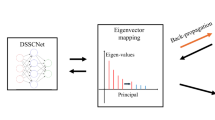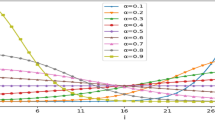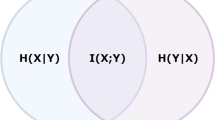Abstract
Recently, manifold regularization with the affinity graph in matrix factorization-related studies, such as dual-graph regularized concept factorization (GCF), have yielded impressive results for clustering. However, due to the noisy and irrelevant features of the data samples, the affinity graph constructed directly from the original feature space is not necessarily a reliable reflection of the intrinsic manifold of the data samples. To overcome this problem, we integrate feature selection into the construction of the data (feature) graph and propose a novel algorithm called adaptive dual-graph regularized CF with Feature selection \((\hbox {ADGCF}_{\mathrm{FS}})\), which simultaneously considers the geometric structures of both the data manifold and the feature manifold. We unify feature selections, dual-graph regularized CF into a joint objective function and minimize this objective function with iterative and alternative updating optimization schemes. Moreover, we provide the convergence proof of our optimization scheme. Experimental results on TDT2 and Reuters document datasets, COIL20 and PIE image datasets demonstrate the effectiveness of our proposed method.







Similar content being viewed by others
References
Lee DD, Seung HS (1999) Learning the parts of objects by non-negative matrix factorization. Nature 401:788–791
Xu W, Gong Y (2004) Document clustering by concept factorization. In: Proceedings of 2004 international conference on research and development in information retrieval (SIGIR’04), pp 202–209
Wang Y, Jia Y, Hu C, Turk M (2005) Nonnegative matrix factorization framework for face recognition. Int J Pattern Recognit Artif Intell 19(04):295–511
Shahnaz F, Berry MW, Pauca V, Plemmons RJ (2006) Document clustering using nonnegative matrix factorization. Inf Process Manag 42(2):373–386
Guillament D, Vitria M, Schiele B (2003) Introducing a weighted nonnegative matrix factorization for image classification. Pattern Recognit 24(14):2447–2454
Shashua A, Hazan T (2005) Nonnegative tensor factorization with applications to statistics and computer vision. In: Proceedings of the 22nd interational conference on machine learning, pp 792–799
Yangcheng H, Hongtao L, Lei H, Saining X (2014) Pairwise constrained concept factorization for data representation. Neural Netw 52:1–17
Cai D, He X, Han J, Huang T (2011) Graph regularized nonnegative matrix factorization for data representation. IEEE Trans Pattern Anal Mach Intell 33:1548–1560
Cai D, He X, Han J (2011) Locally consistent concept factorization for document clustering. IEEE Trans Knowl Data Eng 23(6):902–913
Dhillon IS (2001) Co-clustering documents and words using bipartite spectral graph partitioning. In: Proceedings of the 7th ACM SIGKDD international conference on knowledge discovery and data mining (KDD), pp 269–274
Dhillon IS, Mallela S, Modha DS (2003) Information-theoretic co-clustering. In: Proceedings of the 9th ACM SIGKDD international conference on knowledge discovery and data mining (KDD), pp 89–98
Ding CHQ, Li T, Peng W, Park H (2006) Orthogonal nonnegative matrix tri-factorization for clustering. In: Proceedings of the 12th ACM SIGKDD international conference on knowledge discovery and data mining (KDD), pp 126–135
Sindhwani V, Hu J, Mojsilovic A (2009) Regularized co-clustering with dual supervision. Adv Neural Inf Process Syst (NIPS) 21:1505–1512
Gu Q, Zhou J (2009) Co-clustering on manifolds. In: Proceedings of the 15th ACM SIGKDD international conference on knowledge discovery and data mining (KDD), pp 359–368
Shang F, Jiao LC, Wang Fei (2012) Graph dual regularization non-negative matrix factorization for co-clustering. Pattern Recognit 45:2237–2250
Ye J, Jin Z (2014) Dual-graph regularized concept factorization for clustering. Neurocomputing 138:120–130
Belkin M, Niyogi P, Sindhwani V (2006) Manifold regularization: a geometric framework for learning from examples. J Mach Learn Res 7:2399–2434
Wang JJ-Y, Bensmail H, Gao X (2014) Feature selection and multi-kernel learning for sparse representation on a manifold. Neural Netw 51:9–16
Wang JJ-Y, Huang JZ, Sun Y, Gao X (2015) Feature selection and multi-kernel learning for adaptive graph regularized nonnegative matrix factorization. Expert Syst Appl 42:1278–1286
Fakhraei S, Soltanian-Zadeh H, Fotouhi F (2014) Bias and stability of single variable classifiers for feature ranking and selection. Expert Syst Appl 41(9):6945–6958
Iquebal A, Pal A, Ceglarek D, Tiwari M (2014) Enhancement of Mahalanobis Taguchi system via rough sets based feature selection. Expert Syst Appl 41(11):8003–8015
Lin C-H, Chen H-Y, Wu Y-S (2014) Study of image retrieval and classification based on adaptive features using genetic algorithm feature selection. Expert Syst Appl 41(9):6611–6621
Sun Y, Todorovic S, Goodison S (2010b) Local-learning-based feature selection for high-dimensional data analysis. IEEE Trans Pattern Anal Mach Intell 32(9):1610–1626
Zhao Z, He X, Cai D, Zhang L, Ng W, Zhuang Y (2016) Graph regularized feature selection with data reconstruction. IEEE Trans Knowl Data Eng 3(28):689–700
Lovasz L, Plummer M (1986) Matching theory. Akad’o emiai Kiad’o, Budapest
Acknowledgments
This work is partially supported by the National Natural Science Foundation of China under Grant Nos. 61373063, 61233011, 61125305, 61375007, 61220301, and by National Basic Research Program of China under Grant No. 2014CB349303. Also this work is supported in part by the Natural Science Foundation of Jiangsu Province (BK20150867), the Natural Science Research Foundation for Jiangsu Universities (13KJB510022), and the Talent Introduction Foundation and Natural Science Foundation of Nanjing University of Posts and Telecommunications (NY212014, NY212039, NY215125).
Author information
Authors and Affiliations
Corresponding author
Rights and permissions
About this article
Cite this article
Ye, J., Jin, Z. Feature Selection for Adaptive Dual-Graph Regularized Concept Factorization for Data Representation. Neural Process Lett 45, 667–688 (2017). https://doi.org/10.1007/s11063-016-9548-4
Published:
Issue Date:
DOI: https://doi.org/10.1007/s11063-016-9548-4




